Charles E W Bean, Diaries, AWM38 3DRL 606/228/1 - Folder - Part 4
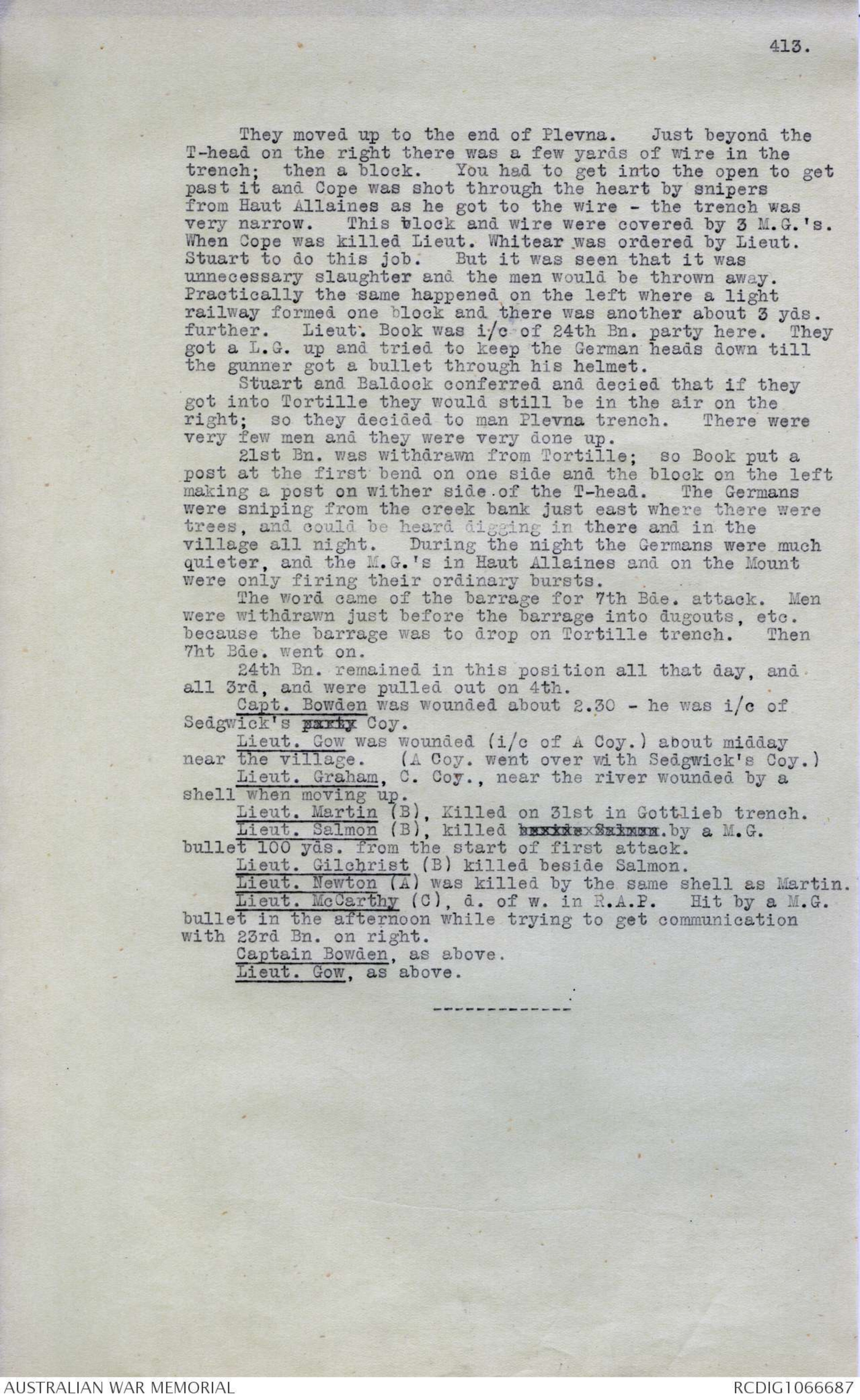
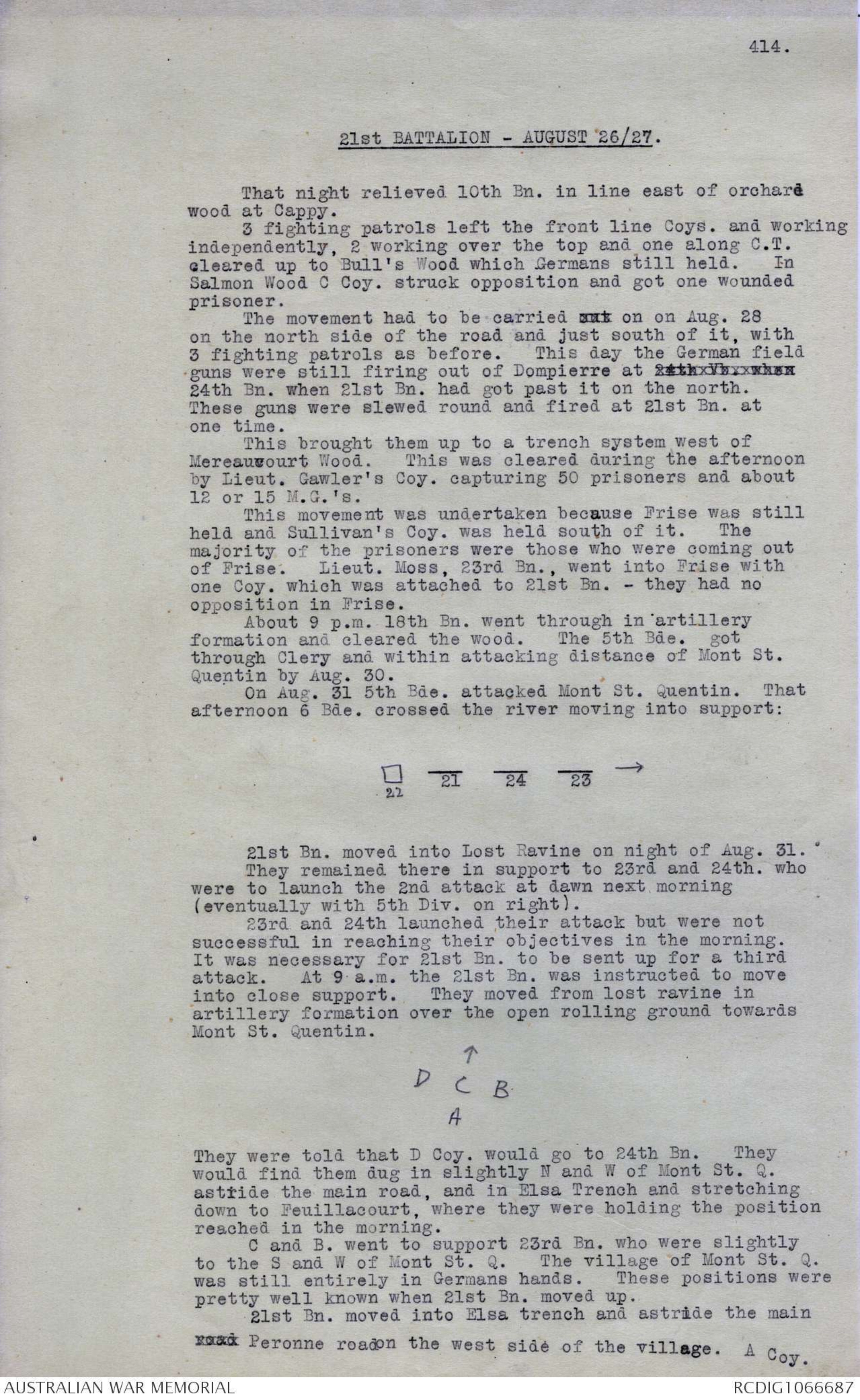
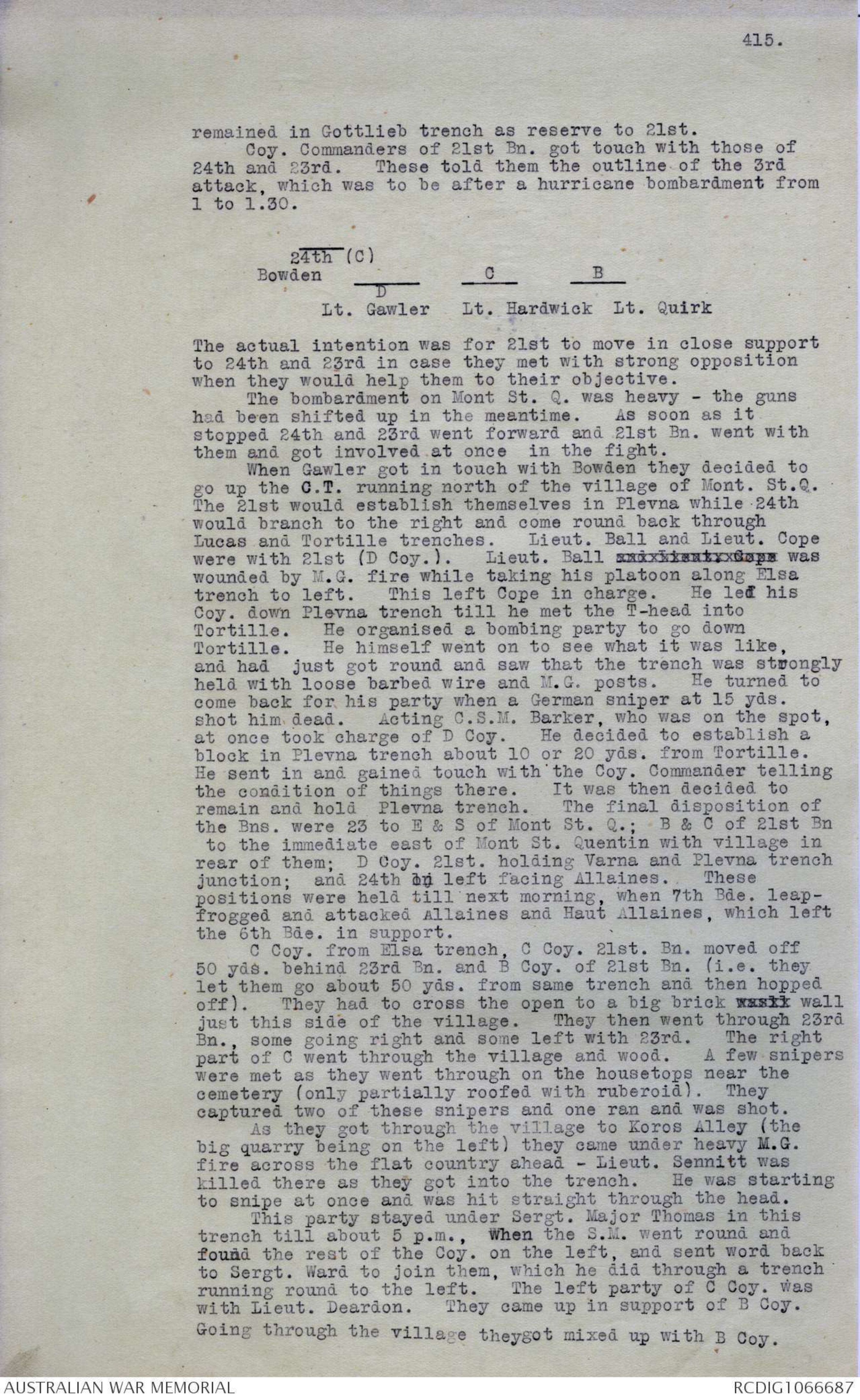
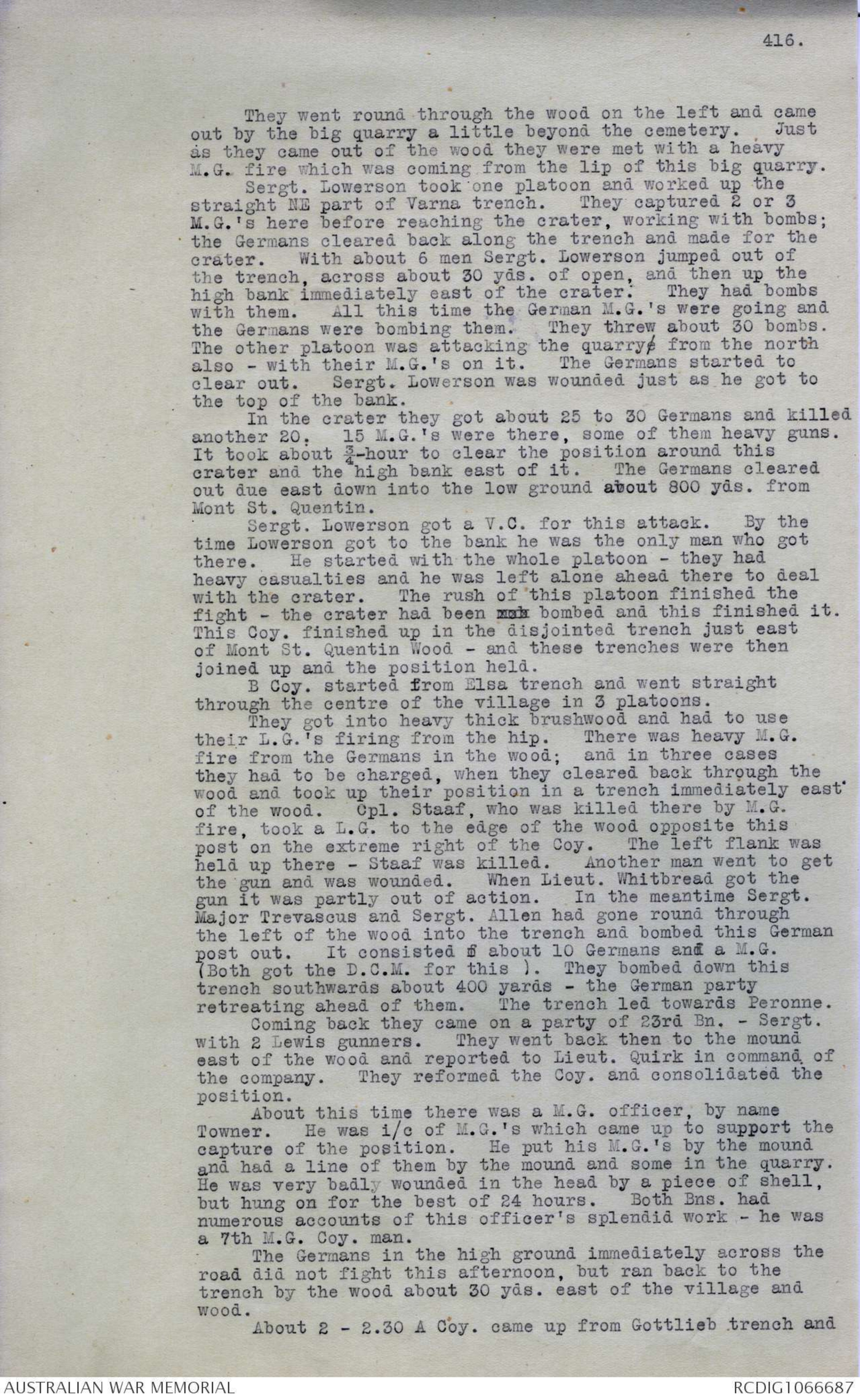
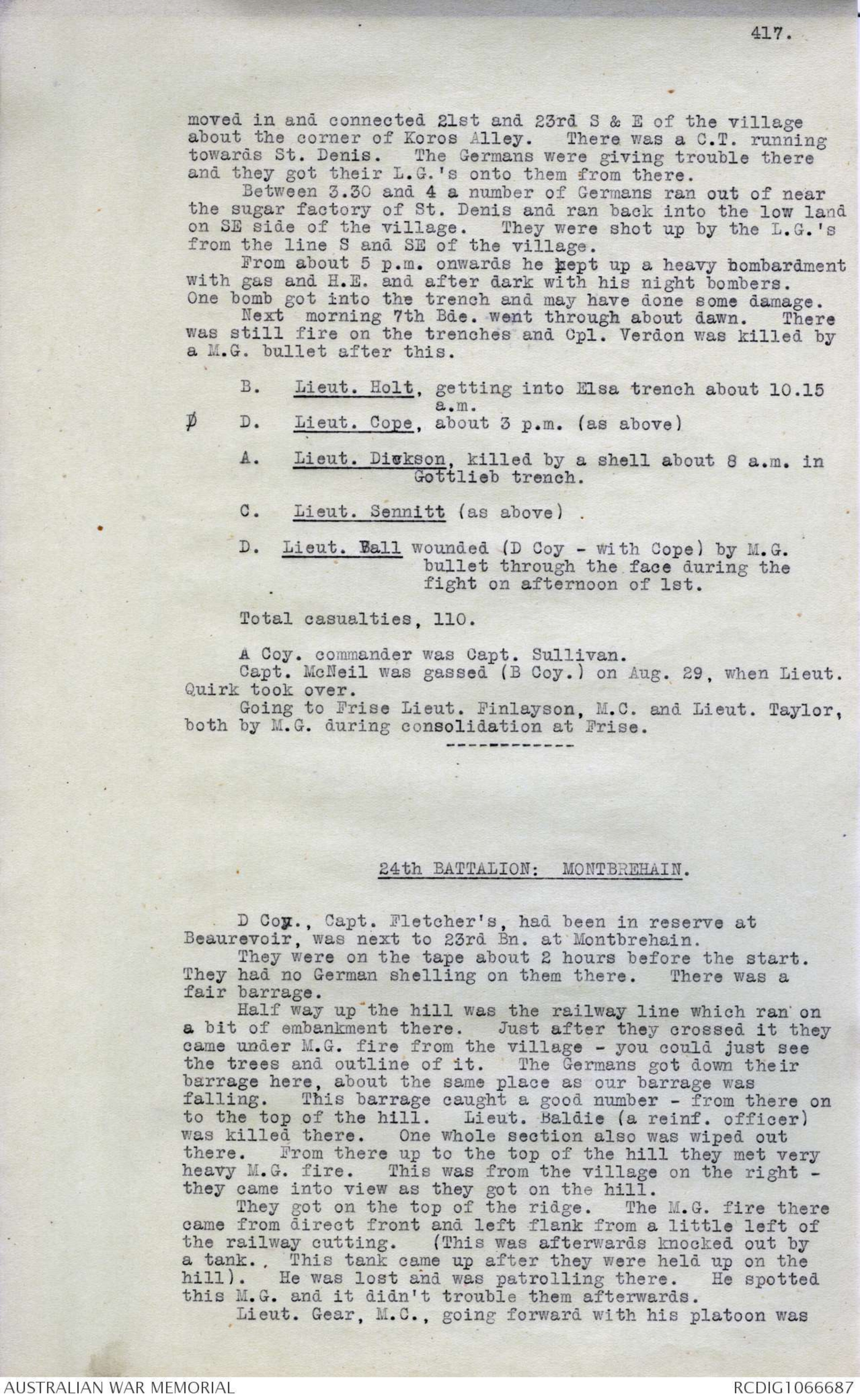
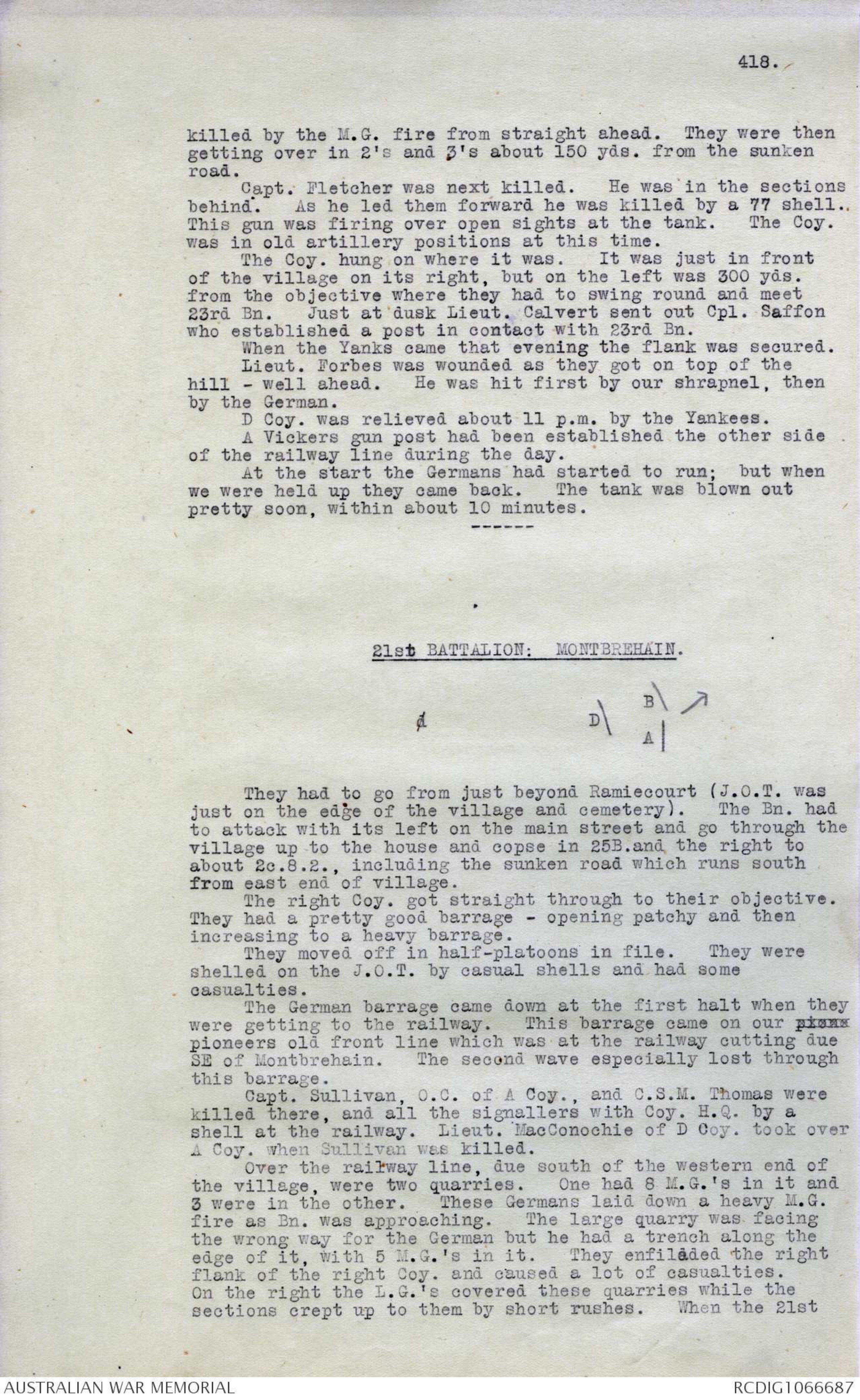
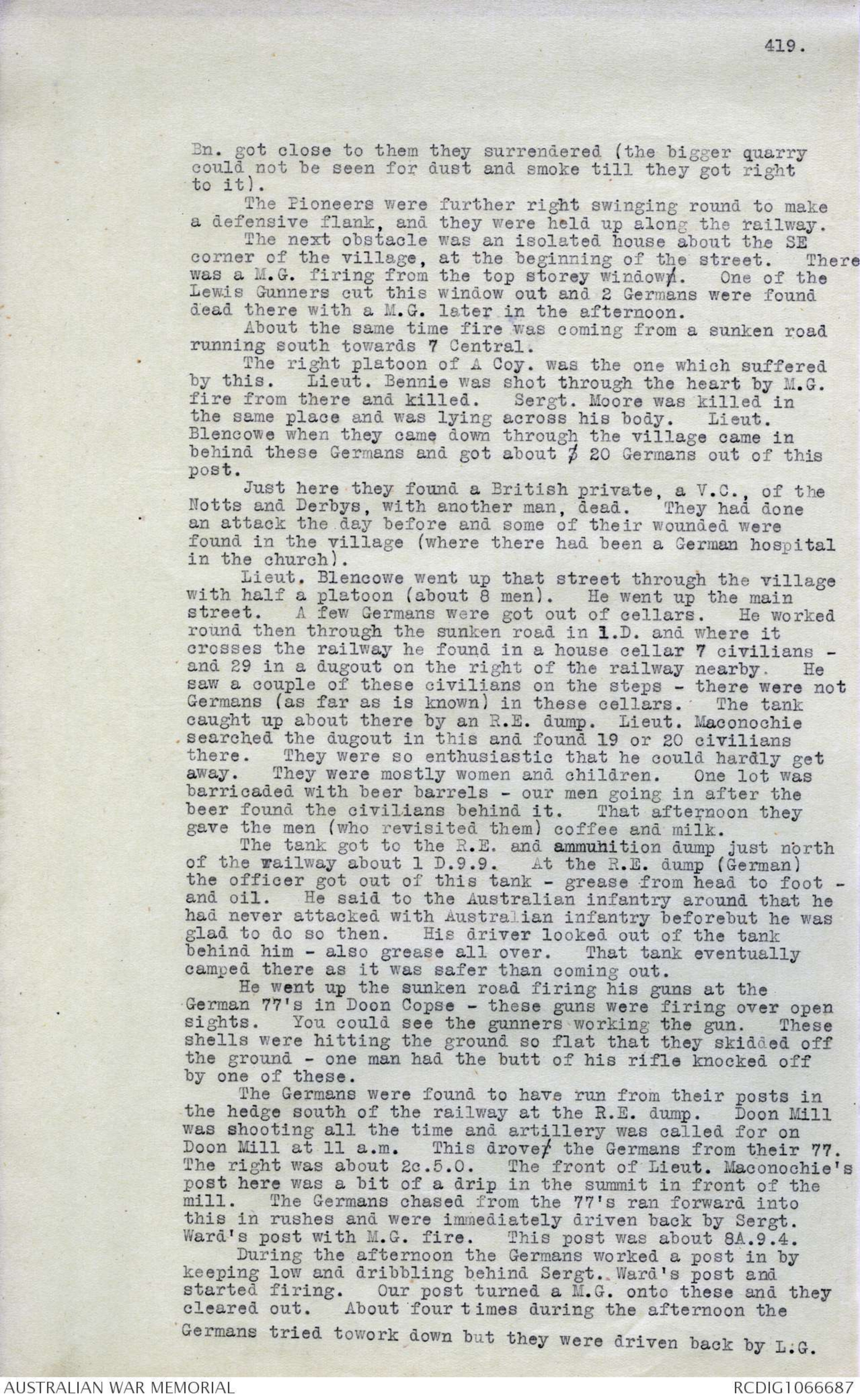
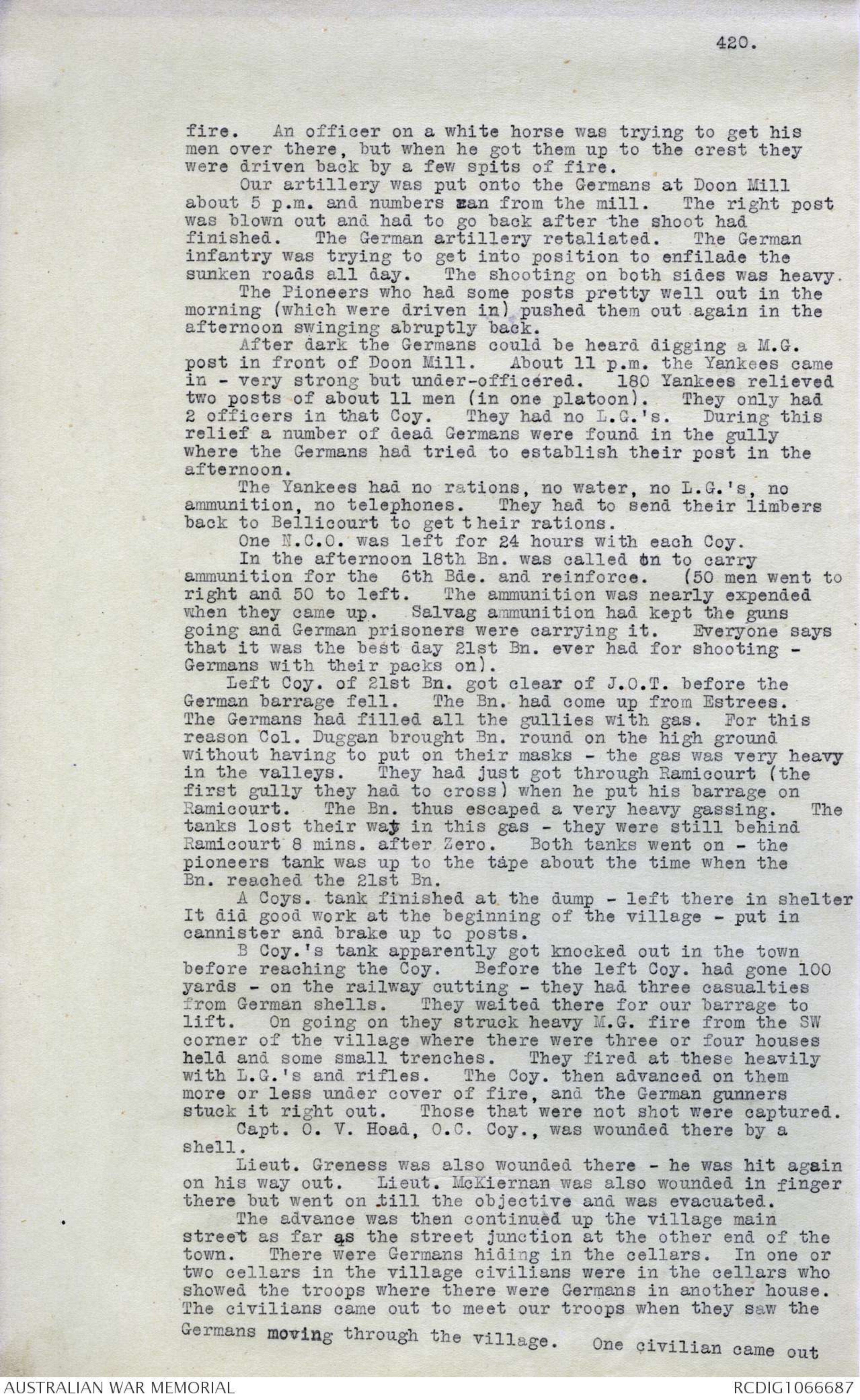
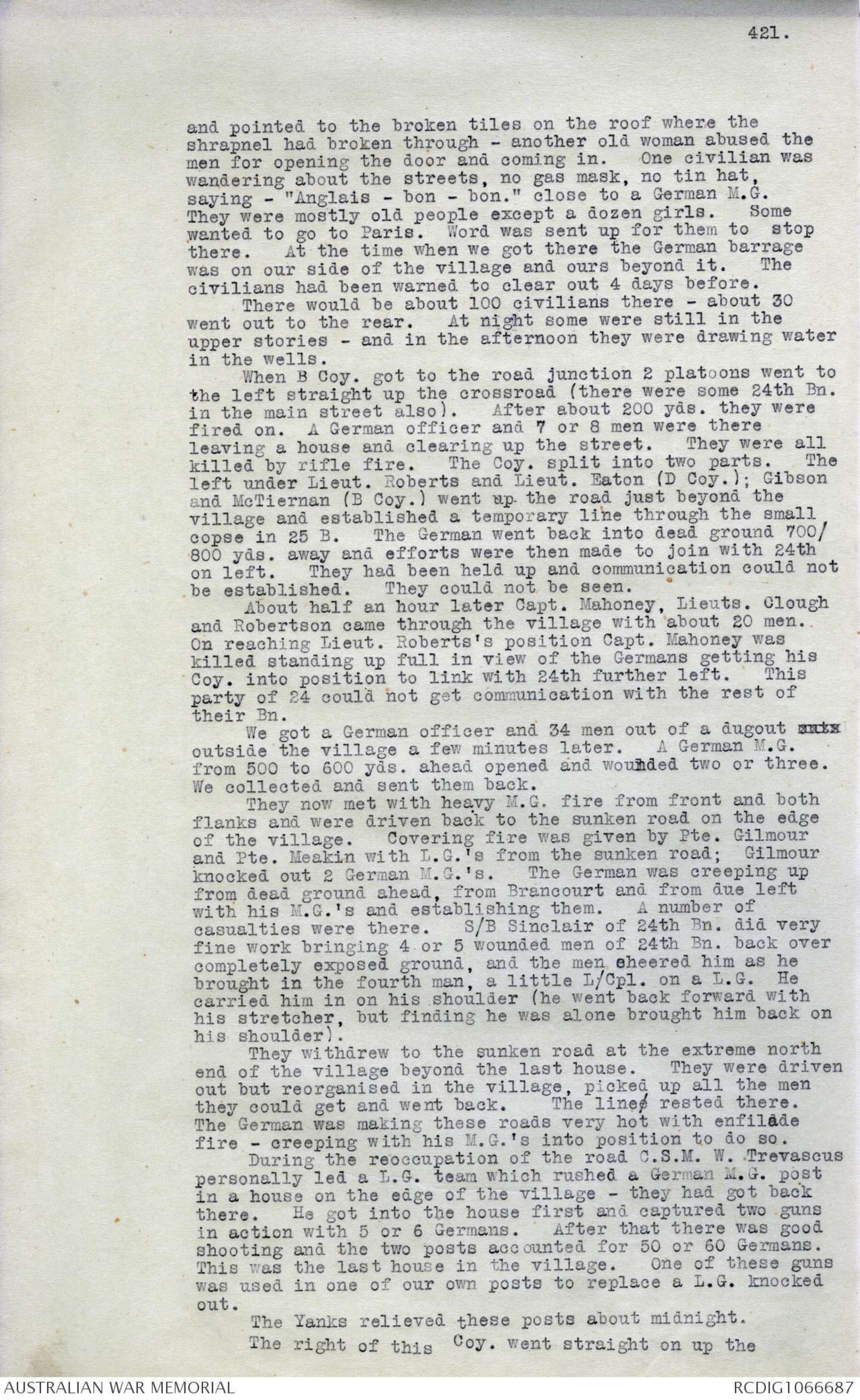
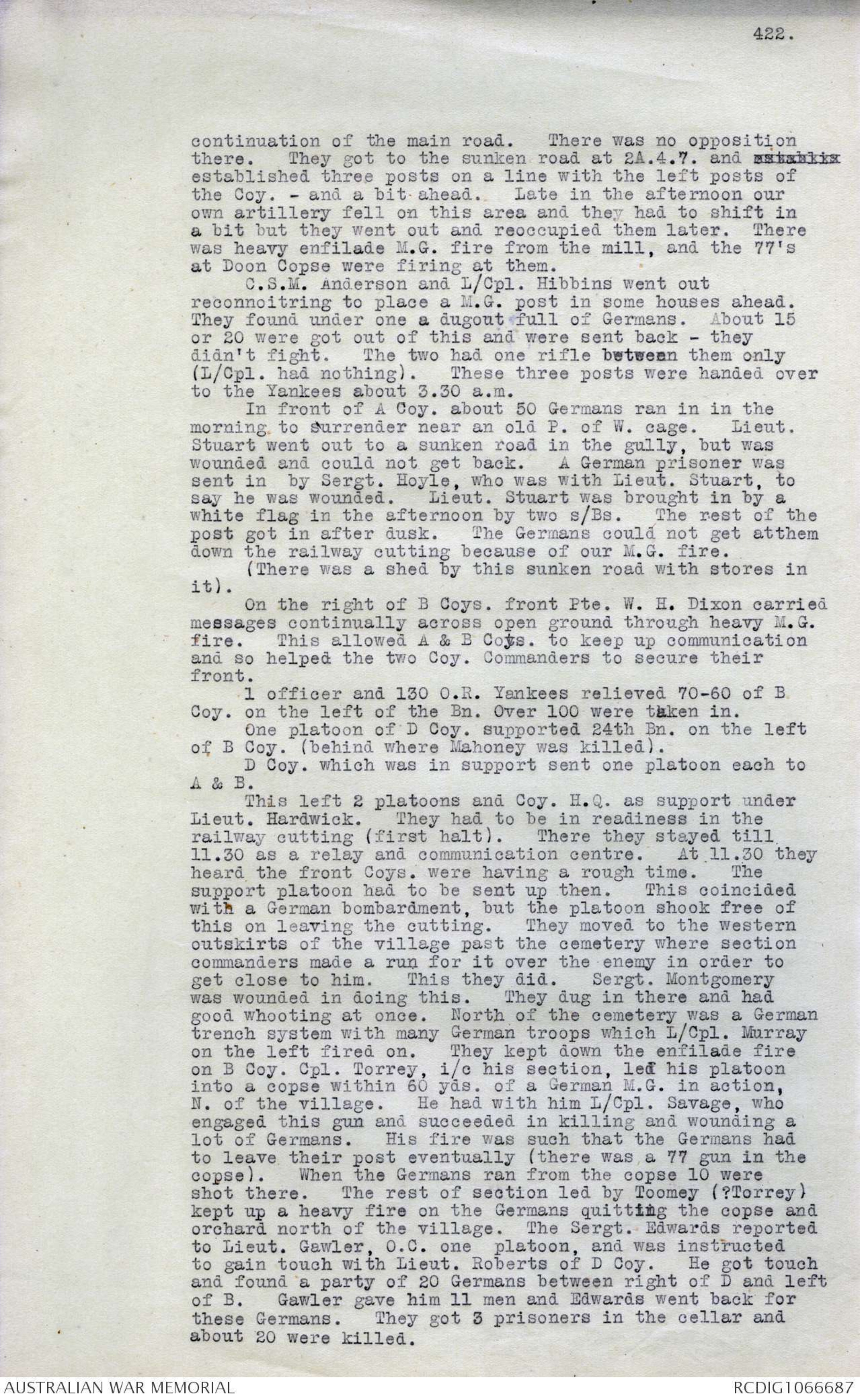
413.
They moved up to the end of Plevna. Just beyond the
T-head on the right there was a few yards of wire in the
trench; then a block. You had to get into the open to get
past it and Cope was shot through the heart by snipers
from Haut Allaines as he got to the wire - the trench was
very narrow. This block and wire were covered by 3 M.G.'s.
When Cope was killed Lieut. Whitear was ordered by Lieut.
Stuart to do this job. But it was seen that it was
unnecessary slaughter and the men would be thrown away.
Practically the same happened on the left where a light
railway formed one block and there was another about 3 yds.
further. Lieut. Book was i/c of 24th Bn. party here. They
got a L.G. up and tried to keep the German heads down till
the gunner got a bullet through his helmet.
Stuart and Baldock conferred and decied that if they
got into Tortille they would still be in the air on the
right; so they decided to man Plevna trench. There were
very few men and they were very done up.
21st Bn. was withdrawn from Tortille; so Book put a
post at the first bend on one side and the block on the left
making a post on wither side of the T-head. The Germans
were sniping from the creek bank just east where there were
trees, and could be heard digging in there and in the
village all night. During the night the Germans were much
quieter, and the M.G.'s in Haut Allaines and on the Mount
were only firing their ordinary bursts.
The word came of the barrage for 7th Bde. attack. Men
were withdrawn just before the barrage into dugouts, etc.
because the barrage was to drop on Tortille trench. Then
7ht Bde. went on.
24th Bn. remained in this position all that day, and.
all 3rd, and were pulled out on 4th.
Capt. Bowden was wounded about 2.30 - he was i/c of
Sedgwick's party Coy.
Lieut. Gow was wounded (i/c of A Coy.) about midday
near the village. (A Coy. went over with Sedgwick's Coy.)
Lieut. Graham, C. Coy., near the river wounded by a
shell when moving up.
Lieut. Martin (B), Killed on 31st in Gottlieb trench.
Lieut. Salmon (B), killed beside Salmon. by a M.G.
bullet 100 yds. from the start of first attack.
Lieut. Gilchrist (B) killed beside Salmon.
Lieut. Newton (A) was killed by the same shell as Martin.
Lieut. McCarthy (C), d. of w. in R.A.P. Hit by a M.G.
bullet in the afternoon while trying to get communication
with 23rd Bn. on right.
Captain Bowden, as above.
Lieut. Gow, as above.
414.
21st BATTALION - AUGUST 26/27.
That night relieved 10th Bn. in line east of orchard
wood at Cappy.
3 fighting patrols left the front line Coys. and working
independently, 2 working over the top and one along C.T.
cleared up to Bull's Wood which Germans still held. In
Salmon Wood C Coy. struck opposition and got one wounded
prisoner.
The movement had to be carried out on on Aug. 28
on the north side of the road and just south of it, with
3 fighting patrols as before. This day the German field
guns were still firing out of Dompierre at 24th Vs. when
24th Bn. when 21st Bn. had got past it on the north.
These guns were slewed round and fired at 21st Bn. at
one time.
This brought them up to a trench system west of
Mereaucourt Wood. This was cleared during the afternoon
by Lieut. Gawler's Coy. capturing 50 prisoners and about
12 or 15 M.G.'s.
This movement was undertaken because Frise was still
held and Sullivan's Coy. was held south of it. The
majority of the prisoners were those who were coming out
of Frise. Lieut. Moss, 23rd Bn., went into Frise with
one Coy. which was attached to 21st Bn. - they had no
opposition in Frise.
About 9 p.m. 18th Bn. went through in artillery
formation and cleared the wood. The 5th Bde. got
through Clery and within attacking distance of Mont St.
Quentin by Aug. 30.
On Aug. 31 5th Bde. attacked Mont St. Quentin. That
afternoon 6 Bde. crossed the river moving into support:
Diagram - see original document
21st Bn. moved into Lost Ravine on night of Aug. 31.
They remained there in support to 23rd and 24th. who
were to launch the 2nd attack at dawn next morning
(eventually with 5th Div. on right).
23rd and 24th launched their attack but were not
successful in reaching their objectives in the morning.
It was necessary for 21st Bn. to be sent up for a third
attack. At 9 a.m. the 21st Bn, was instructed to move
into close support. They moved from lost ravine in
artillery formation over the open rolling ground towards
Mont St. Quentin.
Diagram - see original document
They were told that D Coy. would go to 24th Bn. They
would find them dug in slightly N and W of Mont St. Q.
astride the main road, and in Elsa Trench and stretching
down to Feuillacourt, where they were holding the position
reached in the morning.
C and B. went to support 23rd Bn. who were slightly
to the S and W of Mont St. Q. The village of Mont St. Q.
was still entirely in Germans hands. These positions were
pretty well known when 21st Bn. moved up.
21st Bn. moved into Elsa trench and astride the mainroad Peronne roadon the west side of the village. A Coy.
415.
remained in Gottlieb trench as reserve to 21st.
Coy. Commanders of 21st Bn. got touch with those of
24th and 23rd. These told them the outline of the 3rd
attack, which was to be after a hurricane bombardment from
1 to 1.30.
Diagram - see original document
The actual intention was for 21st to move in close support
to 24th and 23rd in case they met with strong opposition
when they would help them to their objective.
The bombardment on Mont St. Q. was heavy - the guns
had been shifted up in the meantime. As soon as it
stopped 24th and 23rd went forward and 21st Bn. went with
them and got involved.at once, in the fight.
When Gawler got in touch with Bowden they decided to
go up the C.T. running north of the village of Mont. St. Q.
The 21st would establish themselves in Plevna while 24th
would branch to the right and come round back through
Lucas and Tortille trenches. Lieut. Ball and Lieut. Cope
were with 21st (D Coy.). Lieut. Ball and Lieut. Cope was
wounded by M.G. fire while taking his platoon along Elsa
trench to left. This left Cope in charge. He led his
Coy. down Plevna trench till he met the T-head into
Tortille. He organised a bombing party to go down
Tortille. He himself went on to see what it was like,
and had just got round and saw that the trench was strongly
held with loose barbed wire and M.G. posts. He turned to
come back for his party when a German sniper at 15 yds.
shot him dead. Acting C.S.M. Barker, who was on the spot,
at once took charge of D Coy. He decided to establish a
block in Plevna trench about 10 or 20 yds. from Tortille.
He sent in and gained touch with the Coy. Commander telling
the condition of things there. It was then decided to
remain and hold Plevna trench. The final disposition of
the Bns. were 23 to E & S of Mont St. Q.; - B & C of 21st Bn
to the immediate east of Mont St. Quentin with village in
rear of them; D Coy. 21st. holding Varna and Plevna trench
junction; and 24th on left facing Allaines. These
positions were held till next morning, when 7th Bde.
leapfrogged and attacked Allaines and Haut Allaines, which left
the 6th Bde. in support.
C Coy. from Elsa trench, C Coy. 21st. Bn. moved off
50 yds. behind 23rd Bn. and B Coy. of 21st Bn. (i.e. they
let them go about 50 yds. from same trench and then hopped
off). They had to cross the open to a big brick wasll wall
just this side of the village. They then went through 23rd
Bn., some going right and some left with 23rd. The right
part of C went through the village and wood. A few snipers
were met as they went through on the housetops near the
cemetery (only partially roofed with ruberoid). They
captured two of these snipers and one ran and was shot.
As they got through the village to Koros Alley (the
big quarry being on the left) they came under heavy M.G.
fire across the flat country ahead - Lieut. Sennitt was
killed there as they got into the trench. He was starting
to snipe at once and was hit straight through the head.
This party stayed under Sergt. Major Thomas in this
trench till about 5 p.m., When the S.M. went round and
found the rest of the Coy. on the left, and sent word back
to Sergt. Ward to join them, which he did through a trench
running round to the left. The left party of C Coy. was
with Lieut. Deardon. They came up in support of B Coy.
Going through the village theygot mixed up with B Coy.
416.
They went round through the wood on the left and came
out by the big quarry a little beyond the cemetery. Just
as they came out of the wood they were met with a heavy
M.G. fire which was coming from the lip of this big quarry.
Sergt. Lowerson took one platoon and worked up the
straight NE part of Varna trench. They captured 2 or 3
M.G.'s here before reaching the crater, working with bombs;
the Germans cleared back along the trench and made for the
crater. With about 6 men Sergt. Lowerson jumped out of
the trench, across about 30 yds. of open, and then up the
high bank immediately east of the crater. They had bombs
with them. All this time the German M.G.'s were going and
the Germans were bombing them. They threw about 30 bombs.
The other platoon was attacking the quarrye; from the north
also - with their M.G.'s on it. The Germans started to
clear out. Sergt. Lowerson was wounded just as he got to
the top of the bank.
In the crater they got about 25 to 30 Germans and killed
another 20. 15 M.G.'s were there, some of them heavy guns.
It took about ¾-hour to clear the position around this
crater and the high bank east of it. The Germans cleared
out due east down into the low ground about 800 yds. from
Mont St. Quentin.
Sergt. Lowerson got a V.C. for this attack. By the
time Lowerson got to the bank he was the only man who got
there. He started with the whole platoon - they had
heavy casualties and he was left alone ahead there to deal
with the crater. The rush of this platoon finished the
fight - the crater had been rob bombed and this finished it.
This Coy. finished up in the disjointed trench just east
of Mont St. Quentin Wood - and these trenches were then
joined up and the position held.
B Coy. started from Elsa trench and went straight
through the centre of the village in 3 platoons.
They got into heavy thick brushwood and had to use
their L.G.'s firing from the hip. There was heavy M.G.
fire from the Germans in the wood; and in three cases
they had to be charged, when they cleared back through the
wood and took up their position in a trench immediately east
of the wood. Cpl. Staaf, who was killed there by M.G
fire, took a L.G. to the edge of the wood opposite this
post on the extreme right of the Coy. The left flank was
held up there - Staaf was killed. Another man went to get
the gun and was wounded. When Lieut. Whitbread got the
gun it was partly out of action. In the meantime Sergt.
Major Trevascus and Sergt. Allen had gone round through
the left of the wood into the trench and bombed this German
post out. It consisted of about 10 Germans and a M.G.
(Both got the D.C.M. for this). They bombed down this
trench southwards about 400 yards - the German party
retreating ahead of them. The trench led towards Peronne.
Coming back they came on a party of 23rd Bn. - Sergt.
with 2 Lewis gunners. They went back then to the mound
east of the wood and reported to Lieut. Quirk in command of
the company. They reformed the Coy. and consolidated the
position.
About this time there was a M.G. officer, by name
Towner. He was i/c of M.G.'s which came up to support the
capture of the position. He put his M.G.'s by the mound
and had a line of them by the mound and some in the quarry,
He was very badly wounded in the head by a piece of shell,
but hung on for the best of 24 hours. Both Bns. had
numerous accounts of this officer's splendid work - he was
a 7th M.G. Coy. man.
The Germans in the high ground immediately across the
road did not fight this afternoon, but ran back to the
trench by the wood about 30 yds. east of the village and
wood.
About 2 - 2.30 A Coy. came up from Gottlieb trench and
417.
moved in and connected 21st and 23rd S & E of the village
about the corner of Koros Alley. There was a C.T. running
towards St. Denis. The Germans were giving trouble there
and they got their L.G.'s onto them from there.
Between 3.30 and 4 a number of Germans ran out of near
the sugar factory of St. Denis and ran back into the low land
on SE side of the village. They were shot up by the L.G.'s
from the line S and SE of the village.
From about 5 p.m. onwards he kept up a heavy bombardment
with gas and H.E. and after dark with his night bombers.
One bomb got into the trench and may have done some damage.
Next morning 7th Bde. went through about dawn. There
was still fire on the trenches and Cpl. Verdon was killed by
a M.G. bullet after this.
B. Lieut. Holt, getting into Elsa trench about 10.15
a.m.D D. Lieut. Cope, about 3 p.m. (as above)
A. Lieut. Dickson, killed by a shell about 8 a.m. in
Gottlieb trench.
C. Lieut. Sennitt (as above).
D. Lieut. Ball wounded (D Coy - with Cope) by M.G.
bullet through the face during the
fight on afternoon of 1st.
Total casualties, 110.
A Coy. commander was Capt. Sullivan.
Capt. McNeil was gassed (B Coy.) on Aug. 29, when Lieut.
Quirk took over.
Going to Frise Lieut. Finlayson, M.C. and Lieut. Taylor,
both by M.G. during consolidation at Frise.
24th BATTALION: MONTBREHAIN.
D Coy., Capt. Fletcher's, had been in reserve at
Beaurevoir, was next to 23rd Bn. at Montbrehain.
They were on the tape about 2 hours before the start.
They had no German shelling on them there. There was a
fair barrage.
Half way up the hill was the railway line which ran on
a bit of embankment there. Just after they crossed it they
came under M.G. fire from the village - you could just see
the trees and outline of it. The Germans got down their
barrage here, about the same place as our barrage was
falling. This barrage caught a good number - from there on
to the top of the hill. Lieut. Baldie (a reinf. officer)
was killed there. One whole section also was wiped out
there. From there up to the top of the hill they met very
heavy M.G. fire. This was from the village on the right -
they came into view as they got on the hill.
They got on the top of the ridge. The M.G. fire there
came from direct front and left flank from a little left of
the railway cutting. (This was afterwards knocked out by
a tank. This tank came up after they were held up on the
hill). He was lost and was patrolling there. He spotted
this M.G. and it didn't trouble them afterwards.
Lieut. Gear, M.C., going forward with his platoon was
418.
killed by the M.G. fire from straight ahead. They were then
getting over in 2's and 3's about 150 yds. from the sunken
road.
Capt. Fletcher was next killed. He was in the sections
behind. As he led them forward he was killed by a 77 shell.
This gun was firing over open sights at the tank. The Coy.
was in old artillery positions at this time.
The Coy. hung on where it was. It was just in front
of the village on its right, but on the left was 300 yds.
from the objective where they had to swing round and meet
23rd Bn. Just at dusk Lieut. Calvert sent out Cpl. Saffon
who established a post in contact with 23rd Bn.
When the Yanks came that evening the flank was secured.
Lieut. Forbes was wounded as they got on top of the
hill - well ahead. He was hit first by our shrapnel, then
by the German.
D Coy. was relieved about 11 p.m. by the Yankees.
A Vickers gun post had been established the other side
of the railway line during the day.
At the start the Germans had started to run; but when
we were held up they came back. The tank was blown out
pretty soon, within about 10 minutes.
21st BATTALION: MONTBREHAIN.
Diagram - see original document
They had to go from just beyond Ramiecourt (J.O.T. was
just on the edge of the village and cemetery). The Bn. had
to attack with its left on the main street and go through the
village up to the house and copse in 25B.and the right to
about 2c.8.2., including the sunken road which runs south
from east end of village.
The right Coy. got straight through to their objective.
They had a pretty good barrage - opening patchy and then
increasing to a heavy barrage.
They moved off in half-platoons in file. They were
shelled on the J.O.T. by casual shells and had some
casualties.
The German barrage came down at the first halt when they
were getting to the railway. This barrage came on our pionx
pioneers old front line which was at the railway cutting due
SE of Montbrehain. The second wave especially lost through
this barrage.
Capt. Sullivan, O.C. of A Coy., and C.S.M. Thomas were
killed there, and all the signallers with Coy. H.Q. by a
shell at the railway. Lieut. MacConochie of D Coy. took over
A Coy. when Sullivan was killed.
Over the railway line, due south of the western end of
the village, were two quarries. One had 8 M.G.'s in it and
3 were in the other. These Germans laid down a heavy M.G.
fire as Bn. was approaching. The large quarry was facing
the wrong way for the German but he had a trench along the
edge of it, with 5 M.G.'s in it. They enfiladed the right
flank of the right Coy. and caused a lot of casualties.
On the right the L.G.'s covered these quarries while the
sections crept up to them by short rushes. When the 21st
419.
Bn. got close to them they surrendered (the bigger quarry
could not be seen for dust and smoke till they got right
to it).
The Pioneers were further right swinging round to make
a defensive flank, and they were held up along the railway.
The next obstacle was an isolated house about the SE
corner of the village, at the beginning of the street. There
was a M.G. firing from the top storey windown. One of the
Lewis Gunners cut this window out and 2 Germans were found
dead there with a M.G. later in the afternoon.
About the same time fire was coming from a sunken road
running south towards 7 Central.
The right platoon of A Coy. was the one which suffered
by this. Lieut. Bennie was shot through the heart by M.G.
fire from there and killed. Sergt. Moore was killed in
the same place and was lying across his body. Lieut.
Blencowe when they came down through the village came in
behind these Germans and got about 3 20 Germans out of this
post.
Just here they found a British private, a V.C., of the
Notts and Derbys, with another man, dead. They had done
an attack the day before and some of their wounded were
found in the village (where there had been a German hospital
in the church).
Lieut. Blencowe went up that street through the village
with half a platoon (about 8 men). He went up the main
street. A few Germans were got out of cellars. He worked
round then through the sunken road in 1.D. and where it
crosses the railway he found in a house cellar 7 civilians -
and 29 in a dugout on the right of the railway nearby. He
saw a couple of these civilians on the steps - there were not
Germans (as far as is known) in these cellars. The tank
caught up about there by an R.E. dump. Lieut. Maconochie
searched the dugout in this and found 19 or 20 civilians
there. They were so enthusiastic that he could hardly get
away. They were mostly women and children. One lot was
barricaded with beer barrels - our men going in after the
beer found the civilians behind it. That afternoon they
gave the men (who revisited them) coffee and milk.
The tank got to the R.E. and ammunition dump just north
of the railway about 1 D.9.9. At the R.E. dump (German)
the officer got out of this tank - grease from head to foot -
and oil. He said to the Australian infantry around that he
had never attacked with Australian infantry beforebut he was
glad to do so then. His driver looked out of the tank
behind him - also grease all over. That tank eventually
camped there as it was safer than coming out.
He went up the sunken road firing his guns at the
German 77's in Doon Copse - these guns were firing over open
sights. You could see the gunners working the gun. These
shells were hitting the ground so flat that they skidded off
the ground - one man had the butt of his rifle knocked off
by one of these.
The Germans were found to have run from their posts in
the hedge south of the railway at the R.E. dump. Doon Mill
was shooting all the time and artillery was called for on
Doon Mill at 11 a.m. This drover the Germans from their 77.
The right was about 2c.5.0. The front of Lieut. Maconochie's
post here was a bit of a drip in the summit in front of the
mill. The Germans chased from the 77's ran forward into
this in rushes and were immediately driven back by Sergt.
Ward's post with M.G. fire. This post was about 8A.9.4.
During the afternoon the Germans worked a post in by
keeping low and dribbling behind Sergt. Ward's post and
started firing. Our post turned a M.G. onto these and they
cleared out. About four times during the afternoon the
Germans tried towork down but they were driven back by L.G.
420.
fire. An officer on a white horse was trying to get his
men over there, but when he got them up to the crest they
were driven back by a few spits of fire.
Our artillery was put onto the Germans at Doon Mill
about 5 p.m. and numbers ran from the mill. The right post
was blown out and had to go back after the shoot had
finished. The German artillery retaliated. The German
infantry was trying to get into position to enfilade the
sunken roads all day. The shooting on both sides was heavy.
The Pioneers who had some posts pretty well out in the
morning (which were driven in) pushed them out again in the
afternoon swinging abruptly back.
After dark the Germans could be heard digging a M.G.
post in front of Doon Mill. About 11 p.m. the Yankees came
in - very strong but under-officered. 180 Yankees relieved
two posts of about 11 men (in one platoon). They only had
2 officers in that Coy. They had no L.G.'s. During this
relief a number of dead Germans were found in the gully
where the Germans had tried to establish their post in the
afternoon.
The Yankees had no rations, no water, no L.G.'s, no
ammunition, no telephones. They had to send their limbers
back to Bellicourt to get their rations.
One N.C.O. was left for 24 hours with each Coy.
In the afternoon 18th Bn. was called on to carry
ammunition for the 6th Bde. and reinforce. (50 men went to
right and 50 to left. The ammunition was nearly expended
when they came up. Salvag ammunition had kept the guns
going and German prisoners were carrying it. Everyone says
that it was the best day 21st Bn. ever had for shooting -
Germans with their packs on).
Left Coy. of 21st Bn. got clear of J.O.T. before the
German barrage fell. The Bn. had come up from Estrees.
The Germans had filled all the gullies with gas. For this
reason Col. Duggan brought Bn. round on the high ground
without having to put on their masks - the gas was very heavy
in the valleys. They had just got through Ramicourt (the
first gully they had to cross) when he put his barrage on
Ramicourt. The Bn. thus escaped a very heavy gassing. The
tanks lost their way in this gas - they were still behind
Ramicourt 8 mins. after Zero. Both tanks went on - the
pioneers tank was up to the tape about the time when the
Bn. reached the 21st Bn.
A Coys. tank finished at the dump - left there in shelter
It did good work at the beginning of the village - put in
cannister and brake up to posts.
B Coy.'s tank apparently got knocked out in the town
before reaching the Coy. Before the left Coy. had gone 100
yards - on the railway cutting - they had three casualties
from German shells. They waited there for our barrage to
lift. On going on they struck heavy M.G. fire from the SW
corner of the village where there were three or four houses
held and some small trenches. They fired at these heavily
with L.G.'s and rifles. The Coy. then advanced on them
more or less under cover of fire, and the German gunners
stuck it right out. Those that were not shot were captured.
Capt. O. V. Hoad, O.C. Coy., was wounded there by a
shell.
Lieut. Greness was also wounded there - he was hit again
on his way out. Lieut. McKiernan was also wounded in finger
there but went on till the objective and was evacuated.
The advance was then continued up the village main
street as far as the street junction at the other end of the
town. There were Germans hiding in the cellars. In one or
two cellars in the village civilians were in the cellars who
showed the troops where there were Germans in another house.
The civilians came out to meet our troops when they saw the
Germans moving through the village. One civilian came out
421.
and pointed to the broken tiles on the roof where the
shrapnel had broken through - another old woman abused the
men for opening the door and coming in. One civilian was
wandering about the streets, no gas mask, no tin hat
saying - "Anglais - bon - bon." close to a German M.G.
They were mostly old people except a dozen girls. Some
wanted to go to Paris. Word was sent up for them to stop
there. At the time when we got there the German barrage
was on our side of the village and ours beyond it. The
civilians had been warned to clear out 4 days before.
There would be about 100 civilians there - about 30
went out to the rear. At night some were still in the
upper stories - and in the afternoon they were drawing water
in the wells.
When B Coy. got to the road junction 2 platoons went to
the left straight up the crossroad (there were some 24th Bn.
in the main street also). After about 200 yds. they were
fired on. A German officer and 7 or 8 men were there
leaving a house and clearing up the street. They were all
killed by rifle fire. The Coy. split into two parts. The
left under Lieut. Roberts and Lieut. Eaton (D Coy.); Gibson
and McTiernan (B Coy.) went up the road just beyond the
village and established a temporary line through the small
copse in 25 B. The German went back into dead ground 700/800
yds. away and efforts were then made to join with 24th
on left. They had been held up and communication could not
be established. They could not be seen.
About half an hour later Capt. Mahoney, Lieuts. Clough
and Robertson came through the village with about 20 men.
On reaching Lieut. Roberts's position Capt. Mahoney was
killed standing up full in view of the Germans getting his
Coy. into position to link with 24th further left. This
party of 24 could not get communication with the rest of
their Bn.
We got a German officer and 34 men out of a dugout outs
outside the village a few minutes later. A German M.G.
from 500 to 600 yds. ahead opened and wounded two or three.
We collected and sent them back.
They now met with heavy M.G. fire from front and both
flanks and were driven back to the sunken road on the edge
of the village. Covering fire was given by Pte. Gilmour
and Pte. Meakin with L.G.'s from the sunken road; Gilmour
knocked out 2 German M.G.'s. The German was creeping up
from dead ground ahead, from Brancourt and from due left
with his M.G.'s and establishing them. A number of
casualties were there. S/B Sinclair of 24th Bn. did very
fine work bringing 4 or 5 wounded men of 24th Bn. back over
completely exposed ground, and the men cheered him as he
brought in the fourth man, a little L/Cpl. on a L.G. He
carried him in on his shoulder (he went back forward with
his stretcher, but finding he was alone brought him back on
his shoulder).
They withdrew to the sunken road at the extreme north
end of the village beyond the last house. They were driven
out but reorganised in the village, picked up all the men
they could get and went back. The linee rested there.
The German was making these roads very hot with enfilade
fire - creeping with his M.G.'s into position to do so.
During the reoccupation of the road C.S.M. W. Trevascus
personally led a L.G. team which rushed a German M.G. post
in a house on the edge of the village - they had got back
there. He got into the house first and captured two guns
in action with 5 or 6 Germans. After that there was good
shooting and the two posts accounted for 50 or 60 Germans.
This was the last house in the village. One of these guns
was used in one of our own posts to replace a L.G. knocked
out.
The Yanks relieved these posts about midnight.
The right of this Coy. went straight on up the
422.
continuation of the main road. There was no opposition
there. They got to the sunken road at 2A.4.7. and establis
established three posts on a line with the left posts of
the Coy. - and a bit ahead. Late in the afternoon our
own artillery fell on this area and they had to shift in
a bit but they went out and reoccupied them later. There
was heavy enfilade M.G. fire from the mill, and the 77's
at Doon Copse were firing at them.
C.S.M. Anderson and L/Cpl. Hibbins went out
reconnoitring to place a M.G. post in some houses ahead.
They found under one a dugout full of Germans. About 15
or 20 were got out of this and were sent back - they
didn't fight. The two had one rifle between them only
(L/Cpl. had nothing). These three posts were handed over
to the Yankees about 3.30 a.m.
In front of A Coy. about 50 Germans ran in in the
morning to surrender near an old P. of W. cage. Lieut.
Stuart went out to a sunken road in the gully, but was
wounded and could not get back. A German prisoner was
sent in by Sergt. Hoyle, who was with Lieut. Stuart, to
say he was wounded. Lieut. Stuart was brought in by a
white flag in the afternoon by two s/Bs. The rest of the
post got in after dusk. The Germans could not get atthem
down the railway cutting because of our M.G. fire.
(There was a shed by this sunken road with stores in
it).
On the right of B Coys. front Pte. W. H. Dixon carried
messages continually across open ground through heavy M.G.
fire. This allowed A & B Coys. to keep up communication
and so helped the two Coy. Commanders to secure their
front.
1 officer and 130 O.R. Yankees relieved 70-60 of B
Coy. on the left of the Bn. Over 100 were taken in.
One platoon of D Coy, supported 24th Bn. on the left
of B Coy. (behind where Mahoney was killed).
D Coy. which was in support sent one platoon each to
A & B.
This left 2 platoons and Coy. H.Q. as support under
Lieut. Hardwick. They had to be in readiness in the
railway cutting (first halt). There they stayed till
11.30 as a relay and communication centre. At 11.30 they
heard the front Coys. were having a rough time. The
support platoon had to be sent up then. This coincided
with a German bombardment, but the platoon shook free of
this on leaving the cutting. They moved to the western
outskirts of the village past the cemetery where section
commanders made a run for it over the enemy in order to
get close to him. This they did. Sergt. Montgomery
was wounded in doing this. They dug in there and had
good whooting at once. North of the cemetery was a German
trench system with many German troops which L/Cpl. Murray
on the left fired on. They kept down the enfilade fire
on B Coy. Cpl. Torrey, i/c his section, led his platoon
into a copse within 60 yds. of a German M.G. in action,
N. of the village. He had with him L/Cpl. Savage, who
engaged this gun and succeeded in killing and wounding a
lot of Germans. His fire was such that the Germans had
to leave their post eventually (there was a 77 gun in the
copse). When the Germans ran from the copse 10 were
shot there. The rest of section led by Toomey (?Torrey)
kept up a heavy fire on the Germans quitting the copse and
orchard north of the village. The Sergt. Edwards reported
to Lieut. Gawler, O.C. one platoon, and was instructed
to gain touch with Lieut. Roberts of D Coy. He got touch
and found a party of 20 Germans between right of D and left
of B. Gawler gave him 11 men and Edwards went back for
these Germans. They got 3 prisoners in the cellar and
about 20 were killed.
 Loretta Corbett
Loretta CorbettThis transcription item is now locked to you for editing. To release the lock either Save your changes or Cancel.
This lock will be automatically released after 60 minutes of inactivity.